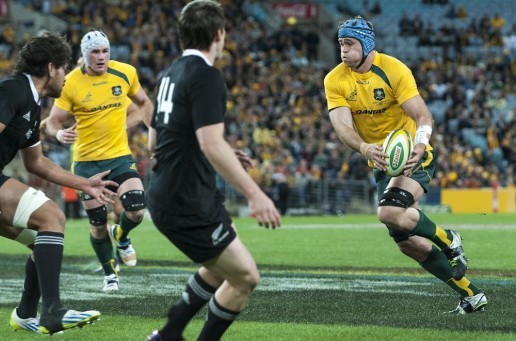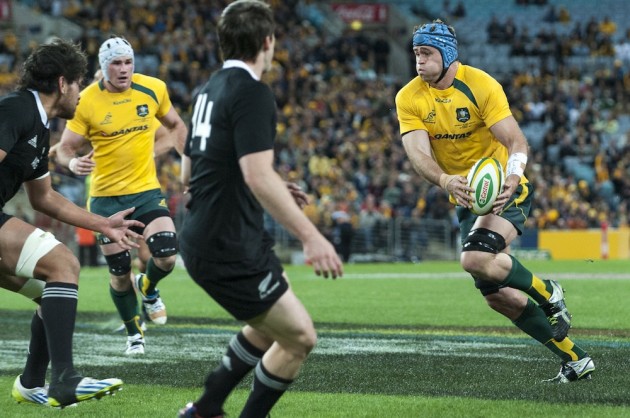A few weeks ago I speculated that one area in which the McKenzie era might mark a real departure from the Deans era was in how the Wallabies create momentum in the forwards and get over the advantage line. I wrote that without a big ball-running No.8, ‘I expect the Wallabies to be a bit smarter, like the Brumbies, and simply reduce their reliance on classic No.8 hit-ups, either by attacking closer to the ruck with pick-and-drives, or wider off No.10.’
Let’s have a look at the first half in Wellington in focus and see whether there has in fact been a shift.
The Old Regime
The default Deans pattern was to utilise pods of three forwards. In theory, the ball can go to any, and the lines run by the ball carrier can be either in towards the ruck, straight, or to the defender’s outside shoulder. This is a pretty effective model at a lower level, but the Wallabies experienced only limited success with it.
One of the key problems is its rigidity; the opposition knows what the attacking set-up, at least, is going to be for each momentum-creating phase. Only rarely did the Wallabies manage to bring the backs into this structure, most memorably for a key try in Durban in 2011:
Even here, however, the limitations are obvious: the forwards are dead static, and so to bring Cooper into the play, he has to run across field instead of straight.
The McKenzie approach
In Bledisloe II there was a substantial diversification of this pattern. In the first thirty minutes of the match, the Wallabies were able to vary their means of getting over the advantage line and creating momentum.
First, we saw moving rather than static pods, usually to start a possession. In essence, structure was sacrificed for speed.
As an auxiliary of this, we saw two runners essentially targeting one hole, which as long as both players are moving at pace, creates a lot more doubt in the defence than having more numerous but static runners.
The second thing we saw was a lot of running the forwards off No.10 instead of No.9. This has the drawback of creating contested rucks in the midfield and trusting your forwards to get there and do the job; it’s a bit more of a risky strategy than staying closer to the ruck. But with a mobile pack like Australia’s, as well as three No.10s in the squad who like the ball in their hands and to dictate play (in contrast to, say, Morne Steyn), it makes a lot of sense.
You’ll see that this is a strategy the Wallabies actually used a lot early on in Bledisloe II. Expect to see it become a regular feature of their attack in the coming months. It’s also a pattern that can be built on over time. Here’s a great example of the ideal scenario from this play, as seen in the Reds’ demolition of the Sharks earlier in the year:
The contrast with the Deans era clip from Durban is stark. The forwards are moving, not static. They’re actually running into holes, not just lining up opposite them. This means the pass from the base can be flatter and more aggressive, giving the opposition less time to get in position and make the tackle.
But the real key to this is outside Faingaa. There’s actually a fourth player moving at the same flat depth there, creating doubt in the defence and providing an offload option, rather than the man outside the runners being deep and not running straight, as Cooper was forced to do in the Durban clip. If McKenzie can get men with pace – Michael Hooper, say, or Ben Mowen – in those outside slots, this can quickly turn from being a momentum-generating strategy into a line-breaking one.
The other benefit of running the forwards off the No.10 is that they can take the ball to the line themselves without the play being telegraphed. The strategy both helps to bring running flyhalves into the game (again, the Wallabies have three of them) and ensures they run straight (to preserve the integrity of the overall strategy). This helped to get Matt Toomua (and for that matter, Christian Leali’ifano) into Bledisloe II when he rarely took it to the line in Bledisloe I.
I expect we might see Quade Cooper develop this yet further, by utilising the inside ball back towards the ruck, as he did to James O’Connor in Bledisloe I, just to keep the opposition forwards honest and prevent them racing up or sliding across.
Finally, Bledisloe I saw the welcome return of the fast close-in play (to be distinguished from the formulaic, slow pick-and-go early in the second half). Even here, there was again variation: both pick-and-drives, a regular feature of the Reds’ play this year, and close in crash-balls, again designed to keep the defence honest.
This “in close” approach is very counter-intuitive but effective, which in a nutshell encapsulates McKenzie’s coaching approach. Usually the inclination with a mobile pack would be to shift the ball wide and stretch the opposition. There was some of this, but the focus in the early part of the match was on using that mobility to shift the point of contact near the ruck; the lead-up to the Stephen Moore disallowed try showed just how effective this could be – provided the ball is quick ball.
Conclusion
It’s worth noting that this approach yielded some success. Each of these substantive possessions in the first half brought results, not to mention that while the Wallabies had the ball and dictated play, the All Blacks couldn’t score any points themselves. It’s also worth noting how simple and surprising the Leali’ifano break ultimately was; it’s difficult to avoid the conclusion that it was the result of diverse pressure on the defensive line at a number of points. Unfortunately the Wallabies then relinquished the initiative for the rest of the match and the scoreline duly slipped out of their control.



